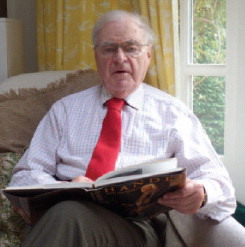Peter Schofield was born in London on September 14, 1929. Before taking up a scholarship at Emmanuel College, Cambridge, he served 2 years of National Service. He recalled that during this time, anyone who appeared to be standing around doing nothing, when challenged, would say he was “coordinating”—a term he would later use in the name of his group at Harwell. After his first degree in mathematics at Cambridge, he worked as a research student in theoretical chemistry.
In October 1956, he joined the Theoretical Physics Division (TPD) of the Atomic Energy Research Establishment (AERE) at Harwell, which at that time was one of the best theoretical physics departments in the country. AERE was at its peak size, with a role to work on the scientific problems arising from the development of nuclear power and on relevant nuclear materials using its new facilities. Peter worked in the new field of neutron thermalization. Peter presented his first paper on neutron energy distribution at a conference in Gatlinburg in 1958. This was followed by a visit to Chalk River where he met Peter Egelstaff, which marked the start of a fruitful collaboration. Their 1962 paper, “On the Evaluation of the Thermal Neutron Scattering Law,” discussed the evaluation of the velocity auto-correlation function for atomic systems, such as liquids, from scattering data, and became a classic. This followed earlier work by Peter on the description of the atomic dynamics of a classical fluid in terms of wavelength-dependent correlation functions and their relation to neutron scattering, research which he worked on and published over the next two decades.
Peter married Kerstin Brück in 1959. They had two daughters, Monica and Amanda, born before and after an extensive period in 1963–5 spent in the USA. Peter made two further long visits to the USA and was visiting scientist in Japan for 6 weeks in 1979.
In 1976, Peter moved to MPD to become Coordinator of Neutron Scattering, which was a challenge with such diverse characters as Ray Lowde, Terry Willis and Colin Windsor to ‘coordinate’! He joined just when three major changes in the neutron environment were taking place. The main applied neutron project at that time in MPD was radiography and Walter Marshall, then Harwell's Director, was urging a move towards more commercial projects. However, the SRC-AEA Joint Research Programme on Neutron Scattering was at its peak, bringing in money and allowing some basic neutron work to still be carried out. Across the fence at the Rutherford Laboratory, it was announced that a new spallation neutron source would be built by the SRC, ISIS.
Despite all these distractions, Peter planned and maintained a steady neutron programme, typically making brief but astute suggestions. He recruited a theoretician, and attracted a post-doc and visitors, particularly Aaron Krawitz, who helped to initiate the group in engineering. Applied work on residual stress measurement, texture and small angle scattering with Maximum Entropy Analysis developed at Southampton University was encouraged and supported. In 1979, Peter succeeded Brian Fender as Chairman of the Neutron Scattering Group of the Institute of Physics, and he suggested, and was consequently asked to organize, a conference and exhibition to mark the 50th anniversary of the discovery of the neutron. The Neutron and its Applications 1982 was held in Cambridge and was a great success. In 1982, Peter was awarded an ScD by Cambridge University. His own work in MPD included neutron scattering from fractal systems and in the European Collaboration on boron neutron capture therapy.
Peter returned to the Theoretical Physics Division in the mid-1980s. Mike Hutchings took over co-ordinating the neutron work until the reactors unexpectedly shut down in 1990. The experience of managing Harwell's neutrons put Peter in good stead to serve as UK Associate Director at the Institut Laue-Langevin in Grenoble from 1991 to 1994. This was a difficult period in the history of the reactor, which was shut down for major reconstruction. There, he used his ‘coordination’ experience to set up, with Jean Charvolin, a new line management structure. The reactor was rebuilt to time and cost.
Peter's main interest outside physics was music. He was an accomplished pianist and accompanist. He also had a love of opera and was an opera critic and reviewer for magazines. His book, The Enjoyment of Opera, summarizes his enthusiasm. Thus, besides being a very astute, respected, and creative physicist, Peter helped to bridge the gap between science and the arts.
Peter made an amusing and telling contribution, “Anecdotal Autobiography” to the History website. (See https://neutronsources.org/about/history/literature.html.
He died on April 15, 2018.

